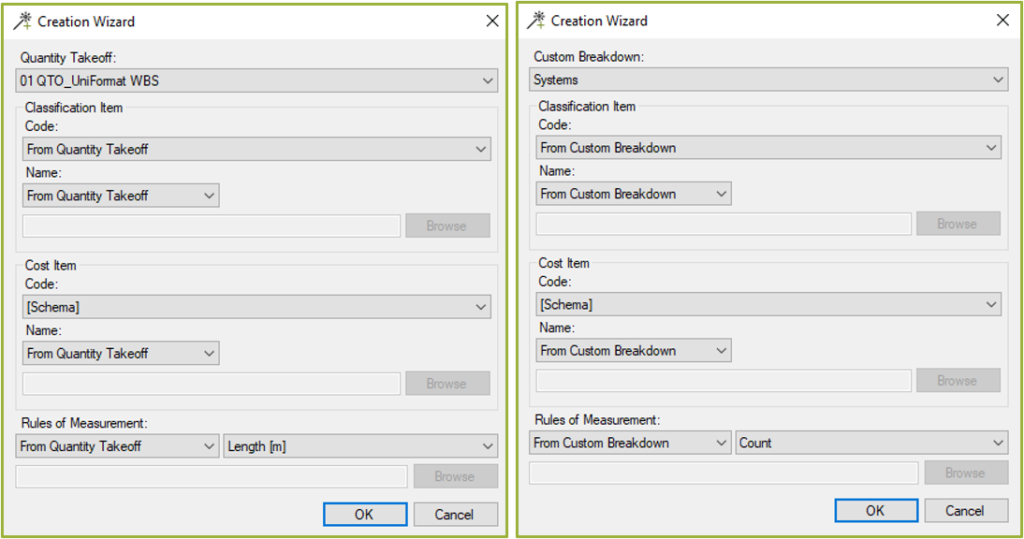Cost Editor palette
The Cost Editor palette is used for creating, importing, and editing cost classification. The Cost Editor tab is located at the bottom of the screen, and it’s divided into three tabs: Classification Editor, Resource Editor and Cost Item Definition Editor.
Classification Editor is the tab with the cost structure of actual cost classification. Users can choose between multiple classifications in the project from the drop-down menu on the command line. This tab consists of all cost items and classification items in actual cost classification. Changes in classification or cost item definition in this tab will only affect actual classification.
The New Classification command allows the creation of new classifications either by creating an entire cost classification directly in BEXEL Manager or by. importing a cost classification from Excel.
The toolbar contains usual commands such as Rename and Delete, which are used to rename or delete created cost classification.
The second toolbar line includes commands such as New, Edit and Delete, which are used for creating, editing, or deleting specific Classification Item and Cost Item. Deleting is possible for one Classification Item and Cost Item or a group of Classification Items and Cost Items.
The first toolbar line also consists of the command Define Code, according to which desired code structure can be defined in the Code Schema Editor window.
Export and Import commands are also available in the first toolbar line to export cost classification to Excel format with or without resources and also to import cost classification from Excel format back to BEXEL Manager.
The Hide Assigned command is used to hide all assigned cost items to BIM model elements and review all unassigned cost items. With the Filter Applicable command, cost items can be filtered per the selection of BIM model elements to easily control which Cost items are linked to certain selected BIM elements. These two commands, Hide Assigned and Filter Applicable, serve as a tool to control cost items and BIM elements in terms of their mutual connection.
The Collapse All, Expand All and Expand to Level commands are used to collapse or expand the whole cost breakdown structure up to a certain level.
A very important command in the second toolbar line for the automatic generation of cost classification is Creation Wizard, with two options to create cost classification from already generated Quantity Takeoff and Custom Breakdown.
After generating cost classification, all cost items can be automatically assigned to the BIM model elements through defined Element Query rules and by using the Auto Assign command in the second toolbar line. Auto Assign can be done to the New Cost version or Active Cost version in the Cost Estimate palette.
The Assigned command allows adding or replacing assignments for the selected elements in the BIM model.
Through the Check Applicable Elements command the issues of the cost assignment process can be easily controlled by automatically creating selection sets according to selected elements or all elements in the cost classification.
The command Select allows selecting Cost Item as per the Cost Classification folder selected or all Classification Item as per the level of the selected Classification Item folder. So if you select Level 2 of the Classification Items folder, all below Classification Items will be selected, including the selected level of Classification Items. Other options that can be selected are Assigned elements, Applicable elements, Applicable Unassigned elements, and Applicable Assigned elements.
Also, columns in the Cost Classification can be manipulated by clicking right-click at the column heather and choosing one of the three options: Column Chooser, Hide Column and Best Fit. By selecting the Column Chooser, a column header can be dragged to the desired location between default column headers and add columns Description, Material Supplement, Labor Supplement, Equipment Supplement, Other Cost, and Subcontractor Cost according to the user’s needs. By selecting the Hide Column option at the desired column header, the selected column will be hidden, and the Best Fit option will shrink or expand the width of the selected column.
The Cost Item Definition Editor tab consists of all Cost items (without Classification items) in the project regardless of cost classification. In this tab all cost items from all classifications in the project can be modified.
The toolbar contains commands such as Edit, Delete and Purge Unused, which are used to edit or delete specific cost items or groups of cost items and purge unused items from all project cost classifications.
If the same Cost item appears more than once within one classification or across different classifications, every copy will be listed as a separate Cost item in this tab. Changes in Cost item definition within one cost item will not affect other copies.
The Resource Editor tab is the tab with information about resources. Every change in resources definition within this tab will affect resources in all cost items and all classifications on the project.
The Add command is used to add new resources to the resource database. A newly created resource will be added at the end of the list where the user must define Resource Code, Description, Type of resource, Quantity Type, and Unit. Finally, Unit Cost can be specified and the Color for each resource can be set, to represent the added resource in the Task Report in the generated Schedule.





